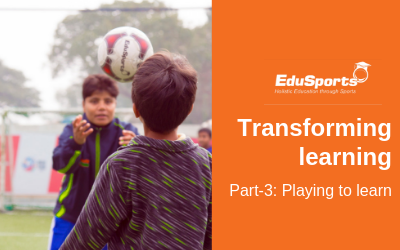“To succeed is to have failed” – learning from failures

Sports for Jack and Jill
– How Physical Education Is Breaking Barriers For Girls
“All work and no play, makes Jack a dull boy”
Wait, what about Jill?
Remember Jill, of the Jack and Jill fame, who was Jack’s accomplice in all games, till they came tumbling down the hill with some bruised knuckles and knees. Does something, deter Jill from playing again the next day, maybe, maybe not!
The disappearing Jills from playgrounds: It starts pretty early in school when girls start dropping out of physical exercises and eventually sports, some out of sheer will, others because they get puberty conscious and some because they are conditioned to think that any form of outside play is meant for boys, not them.
Science at play: Science taught us that while growing up, boys and girls have equal physical strength until they hit puberty, post which boys continue to gain muscular strength while girls either level off or decline. The overall biological explanation is that boys are more active relative to girls (Pellegrini, 2005).
Attitude to gender: There is a slight socio- cultural bigotry in how we perceive a boy indulging in sports vs. a girl showing interest in the same. While a boy is seen as athletic and sturdy, a girl is often termed a ‘tomboy’ (GirlsGlobe.org 2013). As a result, girls start avoiding physically active sports which involve danger, competing or dominance and boys start seeking out other boys as play companions (Maccoby, 1998; Holland, 2003b). We, as parents, teachers, and relatives have our contribution too; from selection of colors for their rooms (a stereotypical blue vs. pink) to gifting them toys (Super heroes, video games vs. Barbie dolls and tea-sets), we somewhere impact their selection of activities. (Pellegrini, Gustafson, 2005)
Girls who play are not tomboys, they are fit: Despite the improving perception of sports, girls who show an interest in physical activities are quickly redirected to more “girlish” interests like painting and music. We tend to overlook the fact that by playing sports, girls (and boys) develop mental toughness and important social and physical skills along with a heightened sense of accomplishment, confidence, determination, and empowerment (GirlsGlobe.org 2015).
Changing the PE landscape: Athletic girls must be celebrated and motivated as much as athletic boys. The schools, which are proactively incorporating structured sports program, are lending a helping hand in this path. While not every girl has a Serena Williams or Saina Nehwal to unleash from within, supporting girls to be participative in physical activities and sports may act as a colossal step in the right direction.
Physical Education can make a difference: Physical education, in its all inclusive manner, can make a great difference in a girl’s outlook towards sports. This shift in attitude could be a great step towards crushing the gender stereotypes, in addition to the benefits that girls will have via their physical and mental development. When girls can perform the same activities as their male counterparts in the field, encouraging equality off the field becomes more viable and rational. Consequently, bridging the gap between girls and physical education will ensure that girls get better prepared to aim for their coveted dreams. Therefore, let the children play, irrespective of their genders!
Reference:
Epstein, E., 2013. Don’t Call Me a Tomboy. Call Me an Athlete.[Online]. Available from: [Accessed 19 January 2016] Girls and Sport: Bridging the Gap.[Online]. Available from: https://girlsglobe.org/2015/06/15/girls-and-sport-bridging-the-gap/ [Accessed 19 January 2016] Holland, P. (2003a), “We don’t play with guns here”: war, weapon and superhero play in the early year (Maidenhead, Open University Press). Maccoby, E.E. (1998), The two sexes: growing up apart, coming together (Cambridge Mass., Belknap and Harvard University). Pellegrini, A.D. (2005) Recess: its role in education and development (Mahwah, New Jersey, Lawrence Erlbaum Associates). Pellegrini, A. D., and Gustafson, K. (2005). Boys’ and girls’ uses of objects for exploration, play and tools in early childhood. In A. D. Pellegrini, and P.K. Smith (Eds.).The nature of play: Great apes and humans.(pp. 113-135). New York: Guilford Press.







